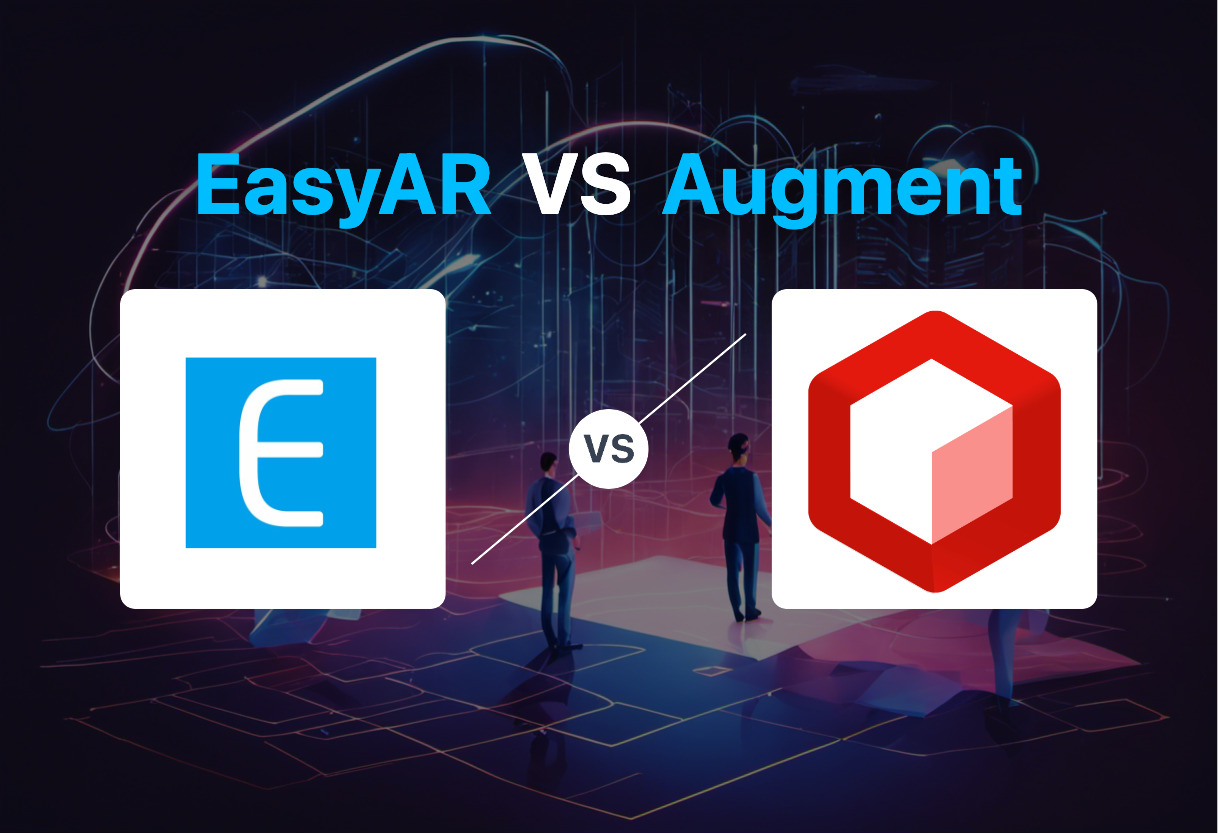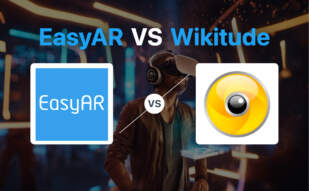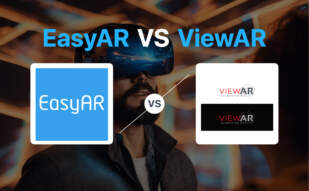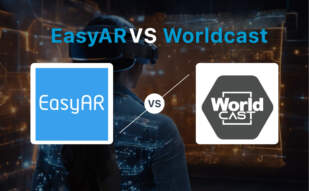For developers seeking fluid AR integration and accurate features, EasyAR wins. While it has unfeasible pricing, its cross-platform and efficient AR tools like SenseMARS and EasyAR SDK are assets. However, for robust industry application, Augment, offering versatile usage from retail to archaeology, should be your pick.

Key Differences Between EasyAR and Augment
- Coding: EasyAR favors seamless AR app development without coding while Augment emphasizes on AR overlay to real-world data.
- Features: EasyAR offers avatar representation in Metaverse, AR Occlusion, Auto-generated lighting. Augment, on the other hand, leverages the utility in interactive marketing, 3D body image visualisation and more.
- Price: EasyAR has a monthly subscription of $39 while Augment operates under undisclosed pricing.
- Usage: EasyAR is proficient in AR software development activities across platforms. Augment focuses on adding tangible value in retail, entertainment, gaming and other industries.
| Comparison | EasyAR | Augmented Reality Technology |
|---|---|---|
| Application Development | AR platform, Offers EasyAR Sense 4.0, algorithm components, motion tracking capabilities, app support for iOS, Android, Windows, macOS. | Used in mobile computing, business applications, retail, healthcare, entertainment and more. |
| Features | Relocalization, persistent AR content, local and cloud-based, AR configurator, AR measurement, AR floor tiling, auto-dynamic lighting and reflections, AR occlusion. Avatar for digital identity. | AR overlays visual, auditory or other sensory information onto the real world for an enhanced user experience. |
| Integration | API Access | AR integrated with employee training, store catalog apps, medical training and more for enhanced learning and visualization. |
| Benefits | Cross-platform support, easy integration, accurate AR features. | Promotion of products/services, launching marketing campaigns, collecting unique user data, design, decision-making, entertainment, navigation, architecture, industrial manufacturing, education. |
| AR Software Type | AR Visualization software, AR Content Management System (CMS), AR Software Development Kit (SDK), AR WYSIWYG Editor Software, AR 3D engine software, AR training simulator software, Industrial AR platforms. | AR adds value to existing real-world environment, does not create own environment like VR. AR Physics-Based Rendering (PBR), marker-based and marker-less AR types. |
| New Releases | EasyAR Mega, city-scale AR cloud solution, SLAM framework based on extensive data system. | Expected developments include AR contact lenses. |
What Is EasyAR and Who’s It For?
EasyAR is an efficient AR platform founded in 2012 in China. Its forte resides in application development and digital animations, enabling users to capture spatial information from the physical environment using a single RGB camera. EasyAR is designed for developers and businesses seeking to build immersive AR applications across platforms like iOS, Android, Windows, and macOS.
EasyAR bolsters its toolkit with AI-enabled AR, Mixed Reality content generation, and cloud engine support. Its functionalities are best suited for sectors such as retail, education, repair & maintenance, and the medical industry.

Pros of EasyAR
- Cross-platform support
- Easy integration
- Accurate AR features
- 3D physical world models with high precision
- User-friendly platform with no coding required for AR app development
Cons of EasyAR
- Unfeasible pricing model
- Lack of optimization
- Limited web support
What Is Augmented Reality (AR) and Who’s It For?
Augmented Reality (AR) is a technology that enhances the real world with digital visuals, sound, and other sensory stimuli. Its purpose transcends highlighting specific features of the physical world—it enables users to derive accessible insights for real-world applications. AR finds its applicability in mobile computing, retail, healthcare, entertainment, and more.
Whether it’s for product visualization, marketing campaigns, gaming, education, or industrial manufacturing, AR can augment one’s experience by overlaying sensory information onto the real world. AR is for businesses looking for interactive experiences, innovative design possibilities, and elevated decision-making abilities.
Pros of Augmented Reality (AR)
- Enhances learning and comprehension during training
- Boosts brand awareness and sales
- Enables better collaboration and safe working conditions
- Delivered via multiple mediums: smartphones, tablets, glasses
- Augmented experiences tied to real-world locations and objects
Cons of Augmented Reality (AR)
- Hardware dependability
- Relies on a strong internet connection for optimal performance
- Digital overlays may detract from real-world experience
- Insufficient regulations on privacy and data security
EasyAR vs Augment: Pricing
While EasyAR comes with a monthly cost of $39, Augment’s pricing details remain undisclosed in the information provided.
EasyAR
The cost of utilizing EasyAR’s capabilities stands at $39 per month, with an option of a free trial. However, it’s cited among the platform’s cons that the pricing could be unfeasible for some users.
Augment
Augment offers a freet trial, but does not give any info on their exact pricing. You’ll need to contact their sales team to get a specific quote.
EasyAR vs Augment: Your Guide to Choose
Here’s the verdict—your tech solution depends on your needs. Let’s dissect the suitable scenarios.
Developers and Tech Enthusiasts
EasyAR is your tool if you seek cross-platform support, accurate AR features or wish to capitalize on AR software’s growing market. Exploit EasyAR SDK for city-scale mapping, localization and Mixed Reality blocking. Caveat- limited web support and lofty pricing.

AR/VR Content Creators
When creating AR/VR content for a large-space experience, EasyAR Meg stands unparalleled. Its city-scale AR cloud solution offers extensive toolchains for AR enthusiasts. However, if a smaller scene is your playground, explore Augment for smaller-scale, sensory AR overlays.
Game Makers
Looking for a no-coding solution? EasyAR lets you auto-spawn and control objects horizontally, vertically or in multiple dimensions. Need a highly interactive, visually-enhanced gaming environment? Turn to Augment to provide captivating in-game experiences.

EasyAR vs Augment verdict: EasyAR outclasses with its extensive AR capabilities and cross-platform support, but comes with a price. Augment excels at providing sensory AR experiences, showing particular strength in gaming and smaller-scale visualizations. Choose your tool based on your individual needs and scale of operation.
Grant Sullivan
Content writer @ Aircada and self proclaimed board game strategist by day, AI developer by night.





